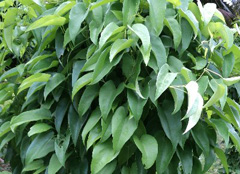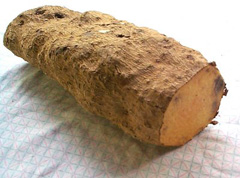 |
|
https://edibleplants.org/ |
 |
| https://edibleplants.org/ |
Translate this page:
Summary
Yellow Yam or Yellow Guinea Yam (Dioscorea cayenensis) is a spiny vine that can be 10 - 12 m long. The leaves are pale green and heart shaped. It is a commercially cultivated for its roots that have a rough outer skin and pale yellow flesh. It is cooked and eaten as vegetable. It can also be dried and milled to produce flour. Leaves are made into tea.
Physical Characteristics

 Dioscorea cayennensis is an evergreen Perennial Climber growing to 10 m (32ft) by 0.5 m (1ft 8in) at a fast rate.
Dioscorea cayennensis is an evergreen Perennial Climber growing to 10 m (32ft) by 0.5 m (1ft 8in) at a fast rate.
See above for USDA hardiness. It is hardy to UK zone 10. The flowers are pollinated by Wind, Insects. The plant is not self-fertile.
Suitable for: light (sandy) and medium (loamy) soils and prefers well-drained soil. Suitable pH: mildly acid, neutral and basic (mildly alkaline) soils and can grow in very acid and very alkaline soils.
It can grow in semi-shade (light woodland) or no shade. It prefers moist soil.
UK Hardiness Map
US Hardiness Map
Synonyms
Dioscorea colocasiifolia Dalz. Non Pax Dioscorea sativa Beatson.
Plant Habitats
Edible Uses
Edible Parts: Leaves Root
Edible Uses: Tea
Root - cooked in various ways and eaten as a vegetable[ 300 , 301 ]. A palatable flavour with a dry, mealy flesh[ 301 ]. The roots are sometimes dried and milled to produce a flour for storing - this flour is then stirred into boiling water and kneaded to form a paste[ 299 ]. The roots have a rough outer skin and a pale yellow flesh[ 301 ].The roots are up to 3kg in weight[ 300 ]. The roots can contain up to 91% carbohydrate, the highest for any yam[ 332 ]. Protein content is low, about 2.5%[ 332 ]. A tea is made from the leaves[ 301 ].
References More on Edible Uses
Medicinal Uses
Plants For A Future can not take any responsibility for any adverse effects from the use of plants. Always seek advice from a professional before using a plant medicinally.
None known
References More on Medicinal Uses
The Bookshop: Edible Plant Books
Our Latest books on Perennial Plants For Food Forests and Permaculture Gardens in paperback or digital formats.

Edible Tropical Plants
Food Forest Plants for Hotter Conditions: 250+ Plants For Tropical Food Forests & Permaculture Gardens.
More

Edible Temperate Plants
Plants for Your Food Forest: 500 Plants for Temperate Food Forests & Permaculture Gardens.
More

More Books
PFAF have eight books available in paperback and digital formats. Browse the shop for more information.
Shop Now
Other Uses
References More on Other Uses
Cultivation details
A plant of the moist, lowland tropics. It grows best in areas where annual daytime temperatures are within the range 20 - 32°c, but can tolerate 12 - 40°c[ 418 ]. Plants can be killed at temperatures of 9°c[ 418 ]. It prefers a mean annual rainfall in the range 1,200 - 1,900mm, but tolerates 900 - 3,000mm[ 418 ]. It prefers a dry season of 2 months or less[ 300 ]. Succeeds in full sun and in moderate shade[ 418 ]. For best yields, this species requires a deep, well-drained, sandy loam that is not liable to water-logging[ 300 ]. Succeeds in relatively light sandy soils[ 300 ], though the soil needs to be very fertile otherwise yields can be low[ 299 ]. Prefers a pH in the range 6 - 6.7, tolerating 5.3 - 8[ 418 ]. Daylengths of more than 12 hours are preferred during the early growing season since this encourages vegetative growth; daylengths of less than 12 hours towards the end of the growing season will encourage tuber formation and development[ 300 ]. Requiring a longer growing season than other yams, mature roots are formed in 9 - 12 months from planting[ 300 ]. The tuber has a very brief resting period and does not store well[ 332 ]. It is in fact best stored, if necessary, in the earth[ 332 ]. The tubers are formed near the surface of the soil[ 332 ] and can be carefully removed from the growing plant without disturbing it, allowing the plant to continue cropping for up to three years[ 300 ]. The tubers can be dug up as required and a common practice is to expose one side of the tuber and to cut away the distal part for consumption leaving the upper part to regenerate; hence the name 'cut-and-come-again'[ 332 ]. This practice may be repeated for upward of three years[ 332 ]. Yields of 30 tonnes per hectare have been obtained in the Caribbean[ 300 ]. There are some named varieties[ 300 ]. Although occasionally monoecious, the plant is usually dioecious, therefore both male and female forms need to be grown if seed is required[ 299 ].
References Carbon Farming Information and Carbon Sequestration Information
Temperature Converter
Type a value in the Celsius field to convert the value to Fahrenheit:
Fahrenheit:
The PFAF Bookshop
Plants For A Future have a number of books available in paperback and digital form. Book titles include Edible Plants, Edible Perennials, Edible Trees,Edible Shrubs, Woodland Gardening, and Temperate Food Forest Plants. Our new book is Food Forest Plants For Hotter Conditions (Tropical and Sub-Tropical).
Shop Now
Plant Propagation
Seed - rarely produced, they are not normally used to propagate this species. Cuttings of tubers. Small tubers can be cut into 2 - 4 sections, larger ones into 6 - 8 sections. Each section should have 2 - 3 dormant buds. The cut tuber is often left in the sun for several hours to promote wound healing and reduce the risk of fungal infection[ 300 ].
Other Names
If available other names are mentioned here
aerial yam air potato air-potato ban tarul bengo nari bhyakur bitter yam brotwurzel buk bulb-bearing yam cheeky yam diha dukarkanda dukkarkanda genthi ghar tyaur githa heggenusu hisaki hoei-oepas hoi huang yao zi huángyàozi igname bulbifère inhame kamfo kanthamul kaya pendazam khashyo khe kisi kukur tarul kunta genusu ofika oviala papa voladora pas phor potatisjams potato yam pousse en l'air ratalu sakkisak tarul teme varahi varahi kand varahi kanda varahi (rhizome) varahika?da yamswurzel ñame de gunda
Native Range
Coming Soon
Weed Potential
Right plant wrong place. We are currently updating this section.
Please note that a plant may be invasive in one area but may not in your area so it's worth checking.
Conservation Status
IUCN Red List of Threatened Plants Status : This taxon has not yet been assessed.

Growth: S = slow M = medium F = fast. Soil: L = light (sandy) M = medium H = heavy (clay). pH: A = acid N = neutral B = basic (alkaline). Shade: F = full shade S = semi-shade N = no shade. Moisture: D = dry M = Moist We = wet Wa = water.
Now available:
Food Forest Plants for Mediterranean Conditions
350+ Perennial Plants For Mediterranean and Drier Food Forests and Permaculture Gardens.
[Paperback and eBook]
This is the third in Plants For A Future's series of plant guides for food forests tailored to
specific climate zones. Following volumes on temperate and tropical ecosystems, this book focuses
on species suited to Mediterranean conditions—regions with hot, dry summers and cool, wet winters,
often facing the added challenge of climate change.
Read More
Expert comment
Author
Lam.
Botanical References
Links / References
For a list of references used on this page please go here
A special thanks to Ken Fern for some of the information used on this page.
Readers comment
| Add a comment |
|
If you have important information about this plant that may help other users please add a comment or link below. Only comments or links that are felt to be directly relevant to a plant will be included. If you think a comment/link or information contained on this page is inaccurate or misleading we would welcome your feedback at [email protected]. If you have questions about a plant please use the Forum on this website as we do not have the resources to answer questions ourselves.
* Please note: the comments by website users are not necessarily those held by PFAF and may give misleading or inaccurate information.
To leave a comment please Register or login here All comments need to be approved so will not appear immediately.
|
Subject : Dioscorea cayennensis
|
|
|
|